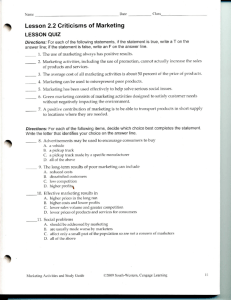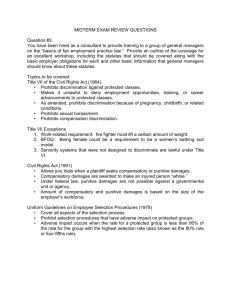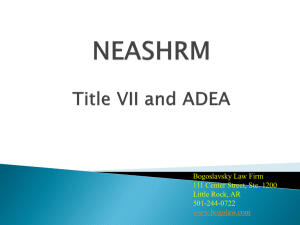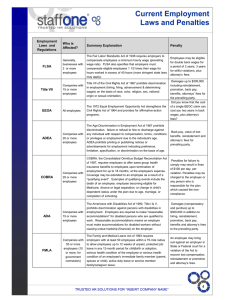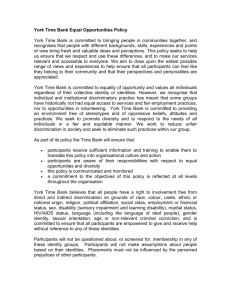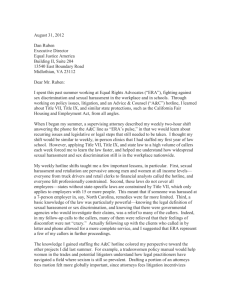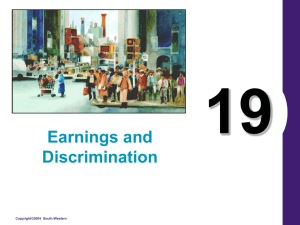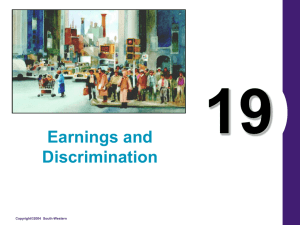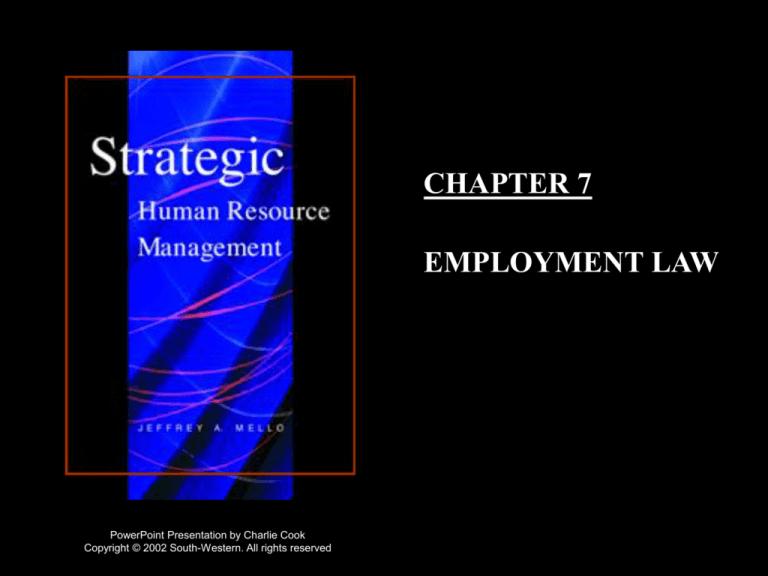
CHAPTER 7
EMPLOYMENT LAW
PowerPoint Presentation by Charlie Cook
Copyright © 2002 South-Western. All rights reserved
Federal Anti-Discrimination Laws
• Equal Pay Act (1963)
– Prohibits wage discrimination based on gender for jobs that
require equal skill, effort, and responsibility and are
performed under similar working conditions.
– Exceptions to equal pay:
•
•
•
•
Bona fide seniority systems
Quality of job performance (i.e., merit-based pay systems)
Quantity of output (i.e., piece-rate pay systems)
Factors (contingencies) other than sex (gender)
Copyright © 2002 South-Western. All rights reserved.
7–2
Federal Anti-Discrimination Laws
• Civil Rights Act (1964)
– Title VII prohibits discrimination in employment based on
race, color, religion, sex, and national origin.
– Covers conditions of employment: hiring, firing, promotion,
transfer, compensation, and admission to training.
– Applies to all private employers with 15 or more employees,
state and local governments, educational institutions,
employment agencies, and unions.
– Established the Equal Employment Opportunity Commission
(EEOC) to oversee and enforce Title VII and all other federal
labor laws.
Copyright © 2002 South-Western. All rights reserved.
7–3
Federal Anti-Discrimination Laws
• Age Discrimination Act (1967)
– Prohibits employment discrimination against employees who
are age 40 or older.
– Prohibits the setting of mandatory retirement ages except in
cases of public safety (e.g., airline pilots).
– Amended 1990 by Older Workers Protection Act which
prohibits discrimination in the provision of benefits and the
required signing of age discrimination waivers at layoff.
– Covers all employers including the federal government.
Copyright © 2002 South-Western. All rights reserved.
7–4
Federal Anti-Discrimination Laws
• Rehabilitation Act (1973)
– Prohibited discrimination by federal (but not private)
contractors against handicapped applicants or employees.
– Definition of handicapped individuals:
• Persons with physical or mental impairment that substantially
limits one or more major life activities.
• Persons with a history or record of such impairment.
• Persons regarded as having such an impairment.
– Handicapped individuals must be “otherwise qualified” to
perform (with reasonable accommodation) the essential
functions of the job (e.g., no blind bus drivers).
Copyright © 2002 South-Western. All rights reserved.
7–5
Federal Anti-Discrimination Laws
• Pregnancy Discrimination Act (1978)
– Prohibits employers from discriminating against pregnant
employees by requiring pregnancy leaves and that
pregnancy be treated as any other medical disability.
– Does not require reinstatement of returning employee to
same job.
– Does not allow employer to determine dates of leave.
– Employer cannot refuse to hire or promote on the basis of
pregnancy.
– Employer cannot provide health plans that do not cover
pregnancy.
Copyright © 2002 South-Western. All rights reserved.
7–6
Federal Anti-Discrimination Laws
• American With Disabilities Act (1990)
– Prohibits all employers with 15 or more employees from
discriminating against handicapped persons.
– The courts have issued ambiguous and conflicting rulings on
“medical conditions”,“major life activities”, and what
constitutes a “disability.” Decisions are made on a case-bycase basis.
– Determination of “reasonable accommodation”:
• Cost of accommodation and resources of employer
• Nature of the job and workplace safety issues
• Any relevant collective bargaining provisions
Copyright © 2002 South-Western. All rights reserved.
7–7
Federal Anti-Discrimination Laws
• Civil Rights Act (1991)
– Extended Title VII coverage to federal employees.
– Allows litigants to sue for compensatory and punitive
damages.
– Requires a heavier “burden of proof” on the part of employers
in rebutting claims of discrimination.
– Provided “extraterritorial enforcement” of federal labor laws in
protecting U.S. employees on overseas assignments where
Title VII compliance does not violate local country laws.
Copyright © 2002 South-Western. All rights reserved.
7–8
Federal Anti-Discrimination Laws
• Family and Medical Leave Act (1992)
– Requires employers to provide up to 12 weeks of unpaid
leave for the birth, adoption, or serious illness of a child,
family member, or the employee during a 12 month period.
– Act only covers organizations with fifty or more employees.
– Employee must have been employed a minimum of 25 hours
per week or 1,250 hours yearly. Employees in top 10% of
employer’s salary range are not covered by the Act.
– Employer is required to continue employee’s group health
coverage during leave.
– Employee must be allowed to return to same/equivalent job.
Copyright © 2002 South-Western. All rights reserved.
7–9
Copyright © 2002 South-Western. All rights reserved.
7–10
EEOC Enforcement of Federal Law
• Burden of proof initially falls on the complainant
(employee) to demonstrate:
– Disparate treatment in deliberate discrimination of a
“protected class” individual or
– Disparate (adverse) impact as a result of the application of a
standard or treatment applied to all individuals that results in
differential outcomes or consequences for protected groups;
usually demonstrated statistically using the four-fifths rule.
– Four-fifths Rule states that the selection rate for protected
class is not 80% of the selection rate for the majority class
then a prima facie case of adverse impact is established.
Copyright © 2002 South-Western. All rights reserved.
7–11
EEOC Enforcement of Federal Law
• Employers rebutting a discrimination case:
– Must demonstrate job-relatedness of any criteria utilized in a
selection process.
– Can claim a bona fide occupational qualification (BFOQ) that
requires the employee to possess a particular personal
characteristic or be a member of a particular group.
– Can use of a bona fide seniority system that was not set up
to intentionally discriminate against a protected class.
– Can claim “business necessity”; that the selection criteria are
essential for safe and efficient operations of the firm.
Copyright © 2002 South-Western. All rights reserved.
7–12
Affirmative Action
• Affirmative Action Plans
– Require organizations to develop, implement, and maintain a
program to make special efforts to insure that their workforce
is representative of the society where the business operates.
– Are required for organizations with 100 or employees and
with $50,000 or more in federal contracts.
– Filed with the Department of Labor and monitored by the
Office of Federal Contract Compliance.
– Are considered temporary measures to correct the
“underutilization” of certain protected classes.
Copyright © 2002 South-Western. All rights reserved.
7–13
Sexual Harassment
• Supreme Court rulings:
– Meritor Savings Bank
• Sexual harassment is a form of sexual discrimination under
Title VII.
– Oncale v. Sundowner Offshore Services
• Same-sex harassment is actionable under Title VII.
• Sexual harassment (definition)
– is an individual’s clear rejection of an offensive and
inappropriate (“unwelcome”) advance.
Copyright © 2002 South-Western. All rights reserved.
7–14
Forms of Sexual Harassment
• Quid pro Quo
– The promise or use of work-related benefits or threats to
bargain with or coerce an individual for sexual favors.
• Hostile working environment
– The presence (perceived or actual) of an offensive or
threatening environment.
• Harassment standards used by the court:
– The “reasonable woman” test.
– Pattern of behavior (frequency and pervasiveness) or isolated
event/act of an individual.
– Response of the organization to the complaint.
Copyright © 2002 South-Western. All rights reserved.
7–15
Copyright © 2002 South-Western. All rights reserved.
7–16
Sexual Harassment
Copyright © 2002 South-Western. All rights reserved.
7–17


